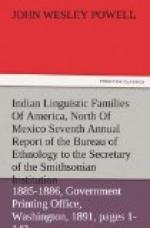Under these circumstances, either under plea of immemorial occupancy or of possession by right of conquest, the land was often claimed, and the claims urged with more or less plausibility by several tribes, sometimes of the same linguistic family, sometimes of different families.
It was often found by the Government to be utterly impracticable to decide between conflicting claims, and not infrequently the only way out of the difficulty lay in admitting the claim of both parties, and in paying for the land twice or thrice. It was customary for a number of different tribes to take part in such treaties, and not infrequently several linguistic families were represented. It was the rule for each tribe, through its representatives, to cede its share of a certain territory, the natural boundaries of which as a whole are usually recorded with sufficient accuracy. The main purpose of the Government in treaty-making being to obtain possession of the land, comparatively little attention was bestowed to defining the exact areas occupied by the several tribes taking part in a treaty, except in so far as the matter was pressed upon attention by disputing claimants. Hence the territory claimed by each tribe taking part in the treaty is rarely described, and occasionally not all the tribes interested in the proposed cession are even mentioned categorically. The latter statement applies more particularly to the territory west of the Mississippi, the data for determining ownership to which is much less precise, and the doubt and confusion respecting tribal boundary lines correspondingly greater than in the country east of that river. Under the above circumstances, it will be readily understood that to determine tribal boundaries within accurately drawn lines is in the vast majority of cases quite impossible.
Imperfect and defective as the terms of the treaties frequently are as regards the definition of tribal boundaries, they are by far the most accurate and important of the means at our command for fixing boundary lines upon the present map. By their aid the territorial possessions of a considerable number of tribes have been determined with desirable precision, and such areas definitely established have served as checks upon the boundaries of other tribes, concerning the location and extent of whose possessions little is known.
For establishing the boundaries of such tribes as are not mentioned in treaties, and of those whose territorial possessions are not given with sufficient minuteness, early historical accounts are all important. Such accounts, of course, rarely indicate the territorial possessions of the tribes with great precision. In many cases, however, the sites of villages are accurately given. In others the source of information concerning a tribe is contained in a general statement of the occupancy of certain valleys or mountain ranges or areas at the heads of certain rivers, no limiting lines whatever being assigned. In others, still, the notice of a tribe is limited to a brief mention of the presence in a certain locality of hunting or war parties.




